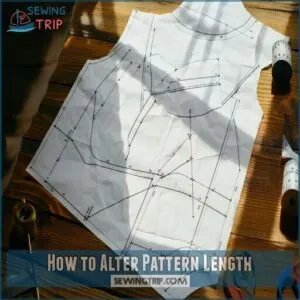This site is supported by our readers. We may earn a commission, at no cost to you, if you purchase through links.
 When it’s sweltering outside, you’ll want to pick fabrics that breathe easy and keep you cool.
When it’s sweltering outside, you’ll want to pick fabrics that breathe easy and keep you cool.
Cotton is a classic choice—it’s soft, airy, and absorbs sweat like a champ. Linen’s another lifesaver, feeling crisp even on humid days, though it wrinkles faster than a paper in a pocket.
For something smooth and drapey, rayon or bamboo are great—it feels like your skin can actually breathe. Steer clear of polyester and nylon since they trap heat and turn you into a personal sauna.
Choosing the right sewing fabric for hot weather is all about balancing comfort and style—stay tuned for ideas to help you make the most of your summer wardrobe with the right fabric.
Table Of Contents
Key Takeaways
- Pick natural fabrics like cotton, linen, or bamboo for breathability, sweat absorption, and staying cool in hot weather.
- Avoid synthetic materials like polyester, nylon, and acrylic since they trap heat and moisture, making you uncomfortable.
- Treat fabrics with moisture-repelling finishes or choose ones with natural antimicrobial and wicking properties to enhance sweat resistance.
- Use lightweight fabrics (30-150 GSM) with loose weaves for better airflow, and consider layering strategically for comfort and versatility.
Best Fabrics for Summer
You’ll stay cool and comfortable during scorching summer days when you choose breathable fabrics like cotton, linen, or bamboo for your sewing projects.
These natural materials allow air to flow freely through your clothing, whisking away sweat before it can make you feel like you’re wearing a personal sauna.
Cotton Benefits
Choosing cotton for your summer projects gives you the perfect mix of comfort and practicality.
This natural fabric lets your skin breathe while absorbing sweat, helping heat escape from your body.
Cotton’s versatility makes it a go-to choice for hot weather sewing.
Cotton offers three major benefits:
- Superior breathability in humid conditions
- Easy care and washing options
- Wide availability in various weights and blends
Cotton’s lightweight nature keeps you feeling fresh even when temperatures soar.
Linen Features
While cotton keeps you comfortable, linen takes summer cooling to another level.
This ancient fabric lets heat escape efficiently through its loose weave while absorbing moisture quickly.
Though notorious for wrinkles, those creases actually help keep fabric from sticking to your skin on hot days.
| Linen Feature | Benefit for Hot Weather |
|---|---|
| Loose Weave | Maximum air circulation |
| Quick-Drying | Prevents clamminess |
| Stiff Texture | Doesn’t cling to skin |
| Natural Fiber | Sustainable choice |
The features of linen, including its loose weave and quick-drying properties, make it an ideal choice for hot weather, providing maximum air circulation and a sustainable option.
Rayon Properties
While linen breezes through summer with its airy weave, rayon brings its own cool personality to hot days.
Rayon’s thin fibers and airy feel make it a summer staple, keeping you cool and stylish on the hottest days.
This man-made fabric blends cotton, wood pulp, and other fibers into something special.
Rayon’s thin fibers let air flow freely, keeping you cool when temperatures climb.
It won’t stick to your skin like some fabrics do, making it perfect for sportswear and summer dresses.
Bamboo Characteristics
Derived from a sustainable source, bamboo fabric offers exceptional comfort in hot weather.
This semi-synthetic rayon keeps you cool when temperatures soar with its impressive thermal regulation properties.
Here’s why bamboo stands out:
- Natural antimicrobial nature prevents odor buildup
- Superior moisture-wicking pulls sweat away from skin
- Low thermal conductivity keeps you cool during activity
- Bamboo blends combine breathability with durability
Merino Wool Advantages
While bamboo offers excellent cooling properties, merino wool might surprise you as a hot weather option.
Unlike traditional wool, merino helps regulate your body temperature even when the mercury rises.
| Property | Benefit | Best For |
|---|---|---|
| Temperature Regulation | Keeps you cool in heat | Outdoor Activities |
| Odor Resistance | Fewer washings needed | Extended wear |
| Moisture-wicking | Stays dry when sweating | Active pursuits |
| Durability Factors | Long-lasting comfort | Travel wear |
Merino’s superfine fibers prevent itching while managing moisture like a champ.
The ZQ Merino label guarantees ethical and sustainable practices in its production.
Fabric Properties Matter
You’ll need to understand fabric properties if you don’t want your summer outfits to feel like portable saunas.
The right fabric will let your skin breathe, wick away moisture, feel lightweight against your body, and stand up to repeated washing in hot weather conditions, which is crucial for summer outfits.
Breathability Importance
After looking at the summer’s best fabrics, let’s talk about why breathability matters so much.
When fabric allows air circulation, your skin can actually breathe. This prevents sweat from clinging to your body, keeping you comfortable in hot weather.
Natural fibers with looser weave density create higher comfort levels. The right breathable, lightweight fabrics work like your personal air conditioning system, maintaining coolness even when temperatures soar.
Moisture-Wicking Benefits
Your body’s comfort in hot weather depends largely on how quickly moisture moves away from your skin.
Moisture-wicking fabrics keep you cool by moving sweat away from your skin, turning summer heat into breezy comfort.
Moisture-wicking fabrics pull sweat outward where it can evaporate faster, keeping you cooler and drier when sewing or wearing your creations.
Polyester is ideal for base layers because it’s lightweight, breathable, and quick-drying.
- Fabrics with good moisture management dry up to 4x faster than standard materials
- Natural wicking options like bamboo offer antimicrobial properties and odor control
- Athletic-inspired fabrics enhance comfort level during peak summer activities
Lightweight Comfort
While moisture-wicking keeps you dry, lightweight comfort guarantees you’ll move freely in hot weather.
The weight of your fabric (measured in GSM ratings) directly impacts how comfortable your summer sewing projects feel.
Fabrics between 30-150 GSM offer that perfect balance for unrestricted movement.
When designing garments, remember that comfort factors aren’t just about breathable fabric—they’re about how the clothes move with you, not against you.
Durability and Care
In terms of durability and care, your summer fabrics need proper attention to last through hot seasons.
Even the most breathable options require maintenance to maintain their cooling properties.
- Wash linen in cold water and air dry to prevent shrinkage
- Remove sweat stains from cotton using vinegar solutions before they set
- Store breathable fabrics in cool, dry places to prevent mildew
Choosing Right Fabric
You’ll save yourself from countless sticky, sweaty summer days when you pick the right fabric for your hot weather sewing projects.
The perfect material lets your skin breathe and wicks moisture away, turning what could be an uncomfortable sauna experience into a breezy, comfortable day.
Supima Cotton Qualities
Supima cotton stands out in the realm of lightweight fabrics due to its extra-long staple fibers.
You’ll notice the difference in strength benefits and softness factor compared to regular cotton. Its superior fiber length creates a smoother texture that won’t irritate your skin during hot days.
Supima offers excellent color retention, resisting fading better than standard cotton. Additionally, it’s grown using traceable, sustainable farming practices – making this breathable fabric both luxurious and environmentally responsible.
Its high thread counts enhance the smoothness.
Ultra Fine Cotton Uses
While Supima cotton offers premium quality, ultra fine cotton takes lightweight fabrics to another level.
You’ll find this breathable fabric in high-end bedding where comfort matters most, luxury bath towels that pamper your skin, and fine clothing that keeps you cool.
It’s perfect for undershirts and shirt linings too.
Home furnishings benefit from its softness, while baby clothing and even some medical textiles utilize its gentle properties.
Many consumers purchase ultra fine cotton products for its superior comfort and because it is ultra fine cotton.
Merino Wool Applications
While ultra-fine cotton feels great against your skin, merino wool offers surprising benefits for summer too.
You’ll find this versatile fabric in everything from lightweight tanks to hiking socks.
Its natural temperature regulation keeps you cool when temperatures rise, while its moisture-wicking properties pull sweat away from your body.
Outdoor apparel companies love merino for its odor resistance and sustainable sourcing. You can find various merino wool products online.
For activewear benefits without the stink, merino wool’s your summer fabric friend!
TENCEL Lyocell Benefits
TENCEL Lyocell offers every sewer five impressive benefits for hot weather clothing.
This sustainable fabric is produced with minimal environmental impact and completely biodegradable.
You’ll appreciate its silky texture and lustrous drape while enjoying excellent moisture-wicking properties.
It’s perfect for those with skin sensitivity issues, keeping you comfortable through summer heat, and the breathable lightweight material provides natural thermal regulation, so your handmade garments will feel cool against your skin all day long.
Modal Fabric Characteristics
While TENCEL Lyocell offers exceptional moisture management, Modal fabric brings its own impressive qualities to hot weather sewing projects.
Made from beech wood pulp, this semi-synthetic material feels luxuriously soft against your skin while keeping you cool.
Modal fabric, also known as HWM rayon, is a popular choice for clothing.
Modal stands out for:
- Its silky-smooth texture that’s perfect for lightweight materials you’ll reach for on scorching days
- Strong moisture-wicking abilities that pull sweat away faster than cotton
- Impressive durability with minimal pilling, even after multiple washes
Fabrics to Avoid
You’ll want to steer clear of fabrics that trap heat and moisture against your skin when sewing for hot weather.
Materials like polyester, nylon, acrylic, heavy wool, and certain types of silk will turn your handmade garments into personal saunas, leaving you uncomfortable and drenched in sweat.
Polyester Disadvantages
While polyester might seem practical for summer sewing projects, it comes with significant drawbacks in hot weather.
This synthetic fabric traps heat against your skin and doesn’t breathe like natural alternatives.
| Issue | Impact | Solution |
|---|---|---|
| Poor breathability | Increased sweating | Choose cotton or linen |
| Heat retention | Uncomfortable clamminess | Opt for natural fibers |
| Static cling | Fabric sticks to skin | Consider moisture-wicking blends |
The key issues with polyester, including poor breathability, heat retention, and static cling, can be mitigated by choosing the right fabric for your summer sewing projects.
Nylon Limitations
While polyester traps heat, nylon has its own set of problems in hot weather.
This synthetic fiber sticks to your skin when you sweat, creating an uncomfortable, clingy sensation. Though marketed for its moisture-wicking properties, nylon actually creates a humidity barrier that prevents proper breathability.
Its low UV resistance means you’ll feel hotter under the sun, and its environmental impact is concerning too.
Pure nylon is known for its resistance to shrinking, but blends with other fabrics may behave differently, so it’s important to check blend dynamics carefully.
For comfort level in summer sewing projects, you’ll want to keep natural alternatives in mind.
Acrylic Drawbacks
In the context of hot weather fabrics, acrylic is your worst enemy.
This synthetic fabric traps heat against your skin, creating a sweaty sauna effect you’ll regret immediately.
Here’s why you should avoid acrylic in summer:
- Poor breathability prevents airflow, causing excessive sweating
- Zero moisture-wicking capability keeps dampness against your skin
- Static cling increases in humid conditions, making garments uncomfortable
- Pilling problems develop quickly, especially in high-friction areas
Heavy Wool Issues
While acrylic fabrics feel uncomfortable, heavy wool presents its own set of problems.
In hot weather, wool overheating is guaranteed – you’ll feel like you’re in a portable sauna. The itchiness factor increases with sweat, making summer days unbearable.
Weight problems and limited breathability mean your body can’t cool down properly. Plus, washing difficulties make wool high-maintenance.
Stick to breathable fabric options like linen fabric or cotton for summer fabrics instead.
Silk Restrictions
While silk feels luxurious against your skin, it comes with several restrictions for hot weather wear.
Silk shows sweat stains easily, creating embarrassing visibility issues when temperatures soar.
It’s also high-maintenance, requiring special care to prevent damage.
The cost factors make silk an impractical choice for everyday summer clothing.
If you’re set on natural fibers, consider more breathable alternatives that won’t highlight perspiration or drain your wallet.
Sewing for Hot Weather
You’ll stay cool and comfortable all summer when you choose the right fabrics for your sewing projects.
Natural fibers like cotton and linen will be your best friends, allowing air to circulate while wicking away sweat from your skin, which helps you stay cool with natural fibers.
Strategic Layering Tips
Even the most breathable summer fabrics can benefit from strategic layering.
Combine lightweight cotton for the layer closest to your skin with looser linen pieces on top for maximum breathability.
For climate adjustment, add a thin bamboo cardigan that you can remove as temperatures rise.
This outfit versatility lets you stay comfortable throughout the day without sacrificing sun protection or style.
Fabric Weave and Design
Beyond strategic layering, the weave of your fabric plays a huge role in breathability.
Loose weaves allow more air circulation, keeping you cooler in hot weather. Tight weaves in fabrics like linen can reduce creasing but might feel warmer.
The Fabric weave structure impacts breathability and drape. When selecting summer fabrics, consider how texture impact and color fastness will hold up under sun exposure.
Popular design aesthetics include animal prints, florals, tie-dye, and color blocking for stylish summer sewing projects.
Maake’s Recommended Fabrics
Now that you’ve mastered fabric weaves, let’s look at Maake’s top recommendations for hot weather sewing.
Calico Cotton offers breathability with classic appeal, while Organic Jersey stretches comfortably against your skin.
For elegant projects, try Organic Satin or airy Organza.
Summer Voile creates lightweight garments that float around you.
Calico Cotton products are available online.
These breathable fabrics keep you cool when temperatures rise, making your summer clothes both stylish and comfortable.
Summer Dress Fabric Considerations
When selecting summer dress fabrics, fabric weight is essential – aim for 30-150 GSM for ideal breathability.
Check the drape suitability before cutting; lightweight cotton and linen will hang differently than heavier materials.
Don’t forget colorfastness testing for fabrics that’ll face sunshine and sweat.
Consider sun protection qualities in your breathable fabric choices, especially for all-day wear.
Print compatibility varies – some summer fabrics hold detailed patterns better than others.
Practical Application Trends
Now that you’ve considered fabric choices for summer dresses, let’s look at what’s trending in practical applications.
Today’s summer sewing projects favor strategic layering with natural materials like regenerative cotton and bamboo fabric.
Weave design matters too – looser weaves enhance breathability in hot climates.
Maake fabrics particularly recommend calming shades in versatile pieces.
You’ll find comfortable summer fabric innovations like recycled materials gaining popularity alongside classic linen and wool blends for seasonless wear.
Frequently Asked Questions (FAQs)
What is the best fabric for working in hot weather?
Lightweight fabrics like linen, cotton, and bamboo are your best bet for hot weather.
They’re breathable, absorb sweat, and dry quickly, keeping you cool while working.
Avoid heavy synthetics—they’ll trap heat and make you miserable.
What type of fabric keeps you cool?
Fabrics like cotton, linen, and bamboo naturally keep you cool in hot weather by allowing airflow and wicking away sweat.
Linen feels crisp, cotton’s soft, and bamboo even fights odors—perfect for those sweaty days!
What is the best lining fabric for hot weather?
Are you tired of feeling sticky in the heat?
Go for cotton voile or lightweight silk for lining—it’s breathable, soft, and keeps you cool without adding bulk.
Perfect comfort for those blazing summer days!
Is cotton or polyester better for hot, humid weather?
For hot, humid weather, cotton wins.
It’s breathable, absorbs sweat, and keeps you cool.
Polyester traps heat and moisture, making you sticky.
Save polyester for workouts; choose cotton for everyday comfort in the heat.
How do fabric blends affect ventilation?
Blended fabrics, like cotton-polyester, balance breathability and durability.
Ventilation improves when natural fibers are mixed with synthetics, optimizing airflow while keeping moisture-wicking intact.
Just be mindful—some blends may trap more heat than others, affecting overall durability.
What sewing techniques enhance breathability in clothing?
Did you know looser stitches improve airflow?
Use techniques like French seams or serging for durability, but avoid thick seams that trap heat.
Lightweight threads and breathable fabric combinations also help you stay cool and comfy.
Are certain dyes better for hot-weather fabrics?
Stick with dyes that don’t block fabric pores.
Natural and eco-friendly dyes, like plant-based options, let your fabric breathe better.
Avoid heavy or synthetic dyes—they can trap heat, making your clothes less comfortable.
What thread types are ideal for summer garments?
Choose lightweight polyester or cotton threads for summer garments.
They’re strong, breathable, and won’t weigh fabrics down.
Polyester resists moisture, while cotton offers a natural touch.
Both work perfectly for airy, comfortable clothes in the heat.
How can fabric pre-treatment improve sweat resistance?
Think of fabric pre-treatment as sunscreen for clothes—it helps block sweat marks and odors.
Treating fabric with moisture-repelling sprays or absorbent finishes can improve durability, keeping your summer outfits fresh and functional longer.
Conclusion
So, how do you stay cool while sewing fabric for hot weather?
Start with breathable choices like cotton, linen, or bamboo—they’re light, airy, and easy on your skin.
Avoid heat-trapping materials like polyester or nylon, which can make summer unbearable.
Keep an eye on fabric properties like breathability and moisture-wicking to balance comfort and practicality.
Whether crafting summer dresses or casual tops, the right fabric can transform your wardrobe into a stylish, heat-friendly haven.
















